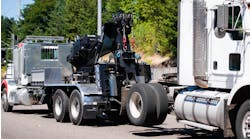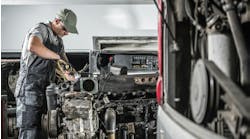According to the Professional Driver Agency (PDA) Top Ten Driver Issues List of 2021, mechanical breakdowns frustrate drivers more than anything else. This study’s sample size was made up of tens of thousands of drivers over several years, PDA said, so fleets should take heed that the cost of downtime isn’t just measured in lost miles or missed deliveries, but also in how long a driver will tolerate their truck’s shop time.
It’s important to note that drivers, who are in high demand, won’t put up with road time fraught with misery, where poorly maintained shocks cause them to feel every bump in their bones or poorly lubed components that cause the steering wheel to shake.
Spec’ing the right equipment for the duty cycle, combined with a proper preventive maintenance strategy, solid pre-trip inspections, and good driver habits are the surest way to avoid breakdowns in general.
“Front axle and suspension maintenance is critical to ensuring the vehicle is being kept in prime condition,” said Sam Marco, senior product manager for front axle at Meritor, which makes suspensions, axles, and associated parts such as kingpins. “And that ultimately will translate to less driver fatigue and a driver staying focused when they’re behind the wheel.”
See also: Reduce habitual speeding and driver fatigue
To reduce that fatigue through the development of new products, Marco looks at reducing three factors: noise, vibration, and harshness (NVH).
“All of those factors strain other components on the vehicle and then ultimately translate to potential driver fatigue,” he explained.
To keep drivers safer and more comfortable, fleet managers and maintenance supervisors need to understand how the various factors fit together.
The driver’s perspective
“It makes a big difference when you got the right suspension,” asserted Bernie Gray, an owner-operator for about 30 years, who recently moved over to a driver trainer at J.J. Keller & Associates, a transportation safety consulting firm.
Gray started out in an old-school Class 8 truck with a “kitchen chair for a driver’s seat,” “arm-strong” steering (meaning you literally needed bulging biceps to keep the truck centered), and a leaf spring suspension that felt more like steel rods bolted to the chassis. In the mid-1990s, he got his first air ride suspensions and power steering.
“That made life so much easier,” he recalled.Life on the road was still hard, going for weeks on end hauling freight. Even with the best maintenance and comfortable ride, the road catches up with a body.
“What I used to be able to accomplish when I was younger is way different than what I can accomplish today,” he noted.
After 3 million safe miles, Gray opted for the trainer gig, teaching box truck, and step-van drivers, along with some heavy-duty truckers, safe driving, and pre- and post-trip inspections. Gray asserted that if he were to take on more freight, he would opt for a more comfortable ride versus slightly higher pay.
“I would much rather lease onto a company that has good, maintained trailers with air ride suspension, rather than spring ride, especially as an owner-operator, because I don't want that trailer beating up on me,” Gray surmised.
He said a bouncy trailer will tug at the tractor, and compensating for that strains the driver’s body while also risking damage to freight and exacerbating wear and tear on the truck.
Air ride systems cost more, and there are additional maintenance considerations. Air ride suspensions require air lines from the compressor, along with a regulator valve. The airbags themselves are also vulnerable to tears and damage.
“If you and your drivers take care of your suspension, your money comes back two-fold,” Gray said of air ride systems. He said part of this is due to less overall maintenance on the tractor-trailer, adding that third-party logistics carriers will also have a wider pool of customers, because “most shipping companies want air ride suspension over the spring rides.”
Shop perspective
“I have been everything from a lube technician to a director of maintenance, and truck drivability and comfort has always been an issue,” said Tim Lamoreaux, truck service manager at North American Trailer, in Inver Grove Heights, Minnesota. “The drivers are in the trucks for 10-plus hours a day and to fight a pull in the steering or deal with vibration is understandably frustrating and fatiguing. I have seen drivers leave because of a drivability issue.”
Lamoreaux also worked at Blaine Brothers’ TruckAline business handles alignments and other axle and suspension service items. The services are also used in-house on Blaine Brothers’ fleet of light- and medium-duty trucks, as well as tow trucks.They use a mix of preventive maintenance scheduling and driver feedback.
“Our vehicles are on our PM program/schedule to monitor for upcoming or unexpected issues, and our heavy tow trucks are aligned whenever the steer axle tires are replaced or if there is a concern reported from our drivers on their DVIR,” noted Blaine Brothers CEO Dean Dally.
Dally also advised to seek out regular alignments at a reputable alignment shop.
“A good alignment shop should identify potential issues that may arise based on current tire wear patterns and with a good thorough inspection before doing the alignment,” he said.
This goes a long way in maximizing steer tire life.
“If the truck was aligned each time the steer tires were replaced, at a minimum, a lot of drivability issues could be avoided,” Dally asserted.
Lamoreaux added that shops should not align a truck with worn steering or suspension parts.
“Kingpins, steering linkages, and suspension pivot points are always checked and anything with play is shown to the customer to let them know our recommendation and let them decide whether to proceed,” he said. “Excessive play will not be aligned, and customers will be advised on repairs needed.”
When alignments are done, Lamoreaux said an absolute must is making sure one person is designated to pre-drive the truck and also test drive that truck when it comes off the rack. He suggested some high-volume shops just go off what the computer says in terms of the positive/negative value of the laser alignment. Technicians should test-drive to confirm proper alignment.
“We get drivers coming in from all over the country, and some of our biggest complaints that you’ll hear from drivers is when the truck just shakes and is always pulling in one direction,” said Irvin Bowman, owner of Ohio-based maintenance provider Wayne Truck and Trailer.
Bowman said many technicians aren’t sure what to look for, but the fix can be quite simple. For example, one might think the steering box is the issue when the truck is pulling, and replacing that leads to more cost and downtime. “Fifty percent of the time, it's not the box when you start getting complaints that way,” Bowman said.
The root cause more likely is a dry fifth wheel, which impedes the trailer’s movement.
See also: Fifth wheel makers keep advancing
“That makes the whole truck kind of feel like it’s darting back and forth on the road,” Bowman said. “It is rather nerve-racking if you ever take one for a drive.” A faulty kingpin may also be a culprit.
Wayne’s technicians are taught to check the basic, more common causes of steering issues first. This includes ensuring the wheels are greased, checking that U-joints and axle components move freely, and verifying adequate oil flow and pressure, Bowman said.
He also pointed out ignoring power steering fluid maintenance could have a big impact, which would affect the steering box. Power steering fluid could “go from doing great to terrible in a short amount of time,” he warned. Routine visual checks with a dipstick would alleviate this. If the fluid is not clear, but more brownish and foamy, there is a problem.
Steering OE Perspective
Manufacturers also have found steering maintenance isn’t always a top priority.
“It’s a pretty simple thing to keep up on from a fleet standpoint, but we see a lot of times that there are fleets that don’t maintain the steering system at all,” said Jonathon Gerke, product manager at Bendix Commercial Vehicle Systems. This is based off examining returned steering gears. Bendix, which supplies aftermarket parts, also owns RH Sheppard.
Exact intervals are in the owner’s manual, but Gerke said steering fluid should be changed annually or every 100,000 miles.
“As that fluid breaks down over time, it’s not giving the lubricity,” Gerke explained. “Also, a lot of high-pressure seals in the gear start to break down as well because the fluid has a lot of contaminants in it.”
A problem is that steering troubleshooting is more specialized, and some technicians opt to simply replace the box. Gerke noted this “is not the most economical way,” as the manufacturer can reject warranty claims if the box is not the issue. Training and implementing a power steering analyzer (a type of pressure and flow gauge) would verify if the steering gear box is bad.
As Meritor’s Marco stated, the goal is to prevent NVH, which can crop up due to misalignments or worn components. To verify a misalignment, investigate the tire wear pattern, Marco said.
“Tires are your key indicators of a problem, specifically within the front axle or within the suspension,” he said. Feathering is a dead giveaway. The tire will exhibit single-edge wear with cupping, or flat patches in the center.
A proper driver pre-check should detect this. Visual inspection will also spot tie rod issues. A driver or technician can then feel for movement to confirm suspicions. Fleets should also investigate when the driver mentions shaking or vibrating at certain rpms or speeds, Marco advised.
Staying consistent on kingpin lubing, as well as aligning the suspension whenever the tires are changed, are two easy methods to circumvent future steering issues as well as extend tire life, he added.
Read the article in its entirety on Fleet Maintenance, FleetOwner's sister publication.






